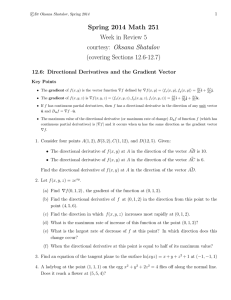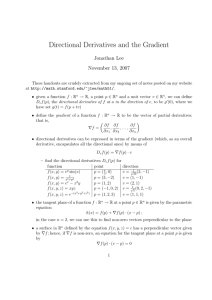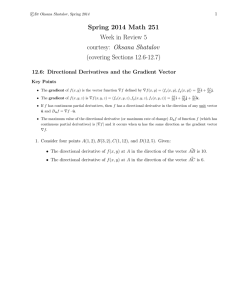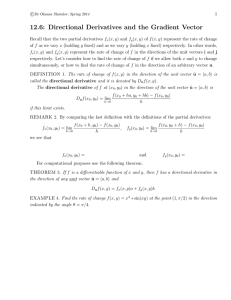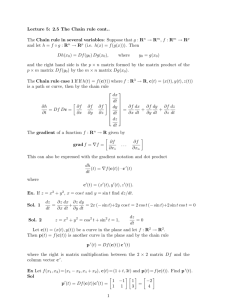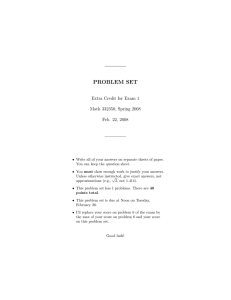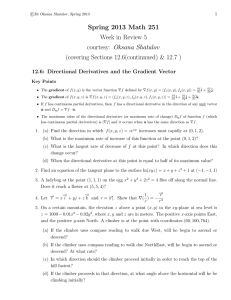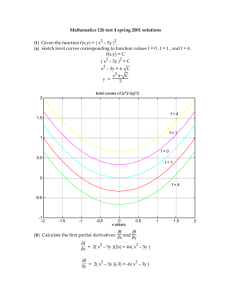Document 10515334
advertisement
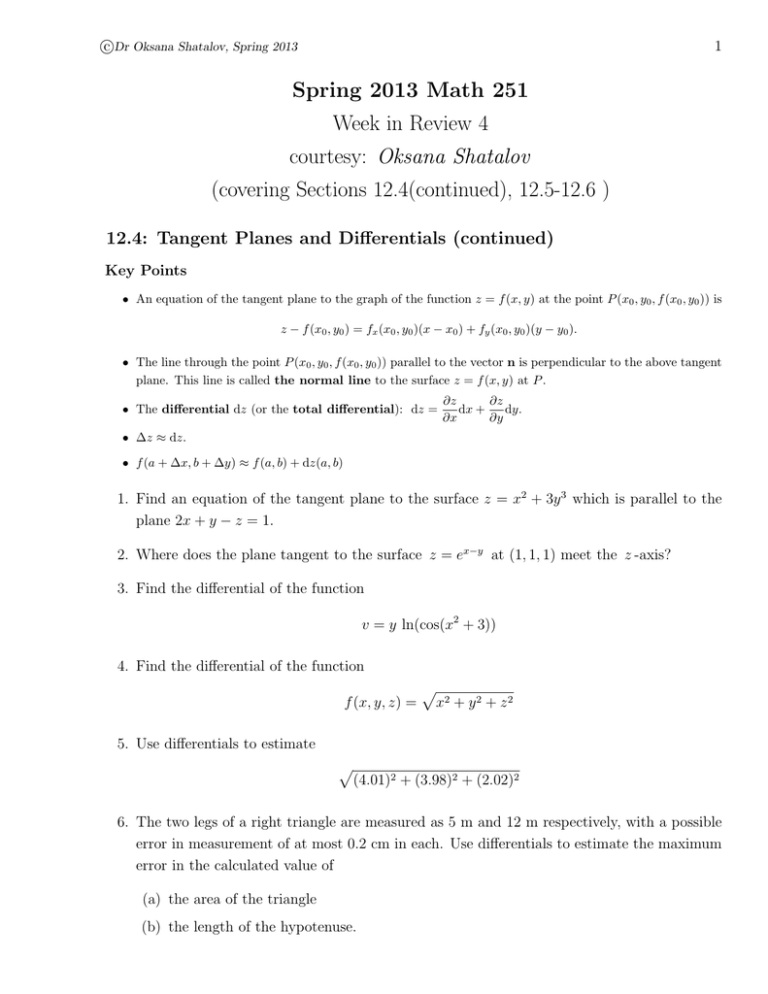
c Dr Oksana Shatalov, Spring 2013 1 Spring 2013 Math 251 Week in Review 4 courtesy: Oksana Shatalov (covering Sections 12.4(continued), 12.5-12.6 ) 12.4: Tangent Planes and Differentials (continued) Key Points • An equation of the tangent plane to the graph of the function z = f (x, y) at the point P (x0 , y0 , f (x0 , y0 )) is z − f (x0 , y0 ) = fx (x0 , y0 )(x − x0 ) + fy (x0 , y0 )(y − y0 ). • The line through the point P (x0 , y0 , f (x0 , y0 )) parallel to the vector n is perpendicular to the above tangent plane. This line is called the normal line to the surface z = f (x, y) at P . • The differential dz (or the total differential): dz = ∂z ∂z dx + dy. ∂x ∂y • ∆z ≈ dz. • f (a + ∆x, b + ∆y) ≈ f (a, b) + dz(a, b) 1. Find an equation of the tangent plane to the surface z = x2 + 3y 3 which is parallel to the plane 2x + y − z = 1. 2. Where does the plane tangent to the surface z = ex−y at (1, 1, 1) meet the z -axis? 3. Find the differential of the function v = y ln(cos(x2 + 3)) 4. Find the differential of the function f (x, y, z) = p x2 + y 2 + z 2 5. Use differentials to estimate p (4.01)2 + (3.98)2 + (2.02)2 6. The two legs of a right triangle are measured as 5 m and 12 m respectively, with a possible error in measurement of at most 0.2 cm in each. Use differentials to estimate the maximum error in the calculated value of (a) the area of the triangle (b) the length of the hypotenuse. c Dr Oksana Shatalov, Spring 2013 2 12.5: The Chain Rule Key Points • CASE 1: z = f (x, y), where x = x(t), y = y(t). dz ∂z dx ∂z dy = + dt ∂x dt ∂y dt CASE 2: z = f (x, y), where x = x(s, t), y = y(s, t). ∂z ∂z ∂x ∂z ∂y = + ∂s ∂x ∂s ∂y ∂s ∂z ∂z ∂x ∂z ∂y = + ∂t ∂x ∂t ∂y ∂t 7. If z = y + f (x2 − y 2 ) , where f has continuous partial derivatives, show that y ∂z ∂z +x =x ∂x ∂y 8. Let w = sin 2x + 3y + y sin x, where x = e−t + 3s, y = 5e2t − Find s ∂w ∂w and . ∂t ∂s 9. Use a chain rule to find the value 10. Find √ √ du at s = 1/4 if u = r2 − r tan θ, r = s, θ = πs. ds ∂z ∂z and ∂x ∂y (a) ln(1 + z) + xy 2 + z = 2013 (b) yz 4 − xz 3 = ex 3 yz 11. Two straight roads intersect at right angles. Ben, walking on one of the roads, approaches the intersection at 0.6m/s and Jill, walking on the other road, approaches the intersection at 0.5m/s. At what rate is the distance between Ben and Jill changing when Ben is 500m from the intersection and Jill is 400m from the intersection? 12. Two sides of a triangle have lengths a = 5m, b = 10m, and the included angle θ = π/6. If the side a is increasing at a rate 2m/s, and the side b is decreasing at a rate of 1m/s, and θ remains constant, at what rate is the third side changing? Is it increasing or decreasing? (Hint: Use the law of cosines.) c Dr Oksana Shatalov, Spring 2013 3 12.6: Directional Derivatives and the Gradient Vector Key Points • The gradient of f (x, y) is the vector function ∇f defined by ∇f (x, y) = hfx (x, y), fy (x, y)i = ∂f ∂f i+ j. ∂x ∂y • The gradient of f (x, y, z) is ∇f (x, y, z) = hfx (x, y, z), fy (x, y, z)i = ∂f ∂f ∂f i+ j+ k. ∂x ∂y ∂z • If f has continuous partial derivatives, then f has a directional derivative in the direction of any unit vector û and Du f = ∇f · û. • The maximum value of the directional derivative (or maximum rate of change) Du f of function f (which has continuous partial derivatives) is |∇f | and it occurs when u has the same direction as the gradient vector ∇f . √ 13. Let f (x, y, z) = x2 y + x 1 + z (a) Find ∇f (1, 2, 3) , the gradient of the function at (1, 2, 3). (b) Find Dv f (1, 2, 3), the directional derivative of f at (1, 2, 3) in the direction from this point to the point (4, 5, 6). 14. Consider four points A(1, 2), B(3, 2), C(1, 12), and D(12, 5). Given: ~ is 10. • The directional derivative of f (x, y) at A in the direction of the vector AB ~ is 6. • The directional derivative of f (x, y) at A in the direction of the vector AC ~ Find the directional derivative of f (x, y) at A in the direction of the vector AD. 15. (a) Find the direction in which f (x, y, z) = zexy increases most rapidly at the point (0, 1, 2). (b) What is the maximum rate of increase of this function at the point (0, 1, 2)? (c) What is the largest rate of decrease of f at this point? In which direction does this change occur? (d) When the directional derivative at this point is equal to half of its maximum value? 16. Find an equation of the tangent plane to the surface ln(xyz) = x + y + z 2 + 1 at the point (−1, −1, 1) c Dr Oksana Shatalov, Spring 2013 4 17. A ladybug at the point (1, 1, 1) on the egg x2 + y 2 + 2z 2 = 4 flies off along the normal line. Does it reach a flower at (5, 5, 4)? → − → − − 18. Let → r = x i + yj + z k and r = |~r| . Show that → − 1 r ∇( ) = − 3 r r 19. On a certain mountain, the elevation z above a point (x, y) in the xy-plane at sea level is z = 1000 − 0.01x2 − 0.02y 2 , where x, y and z are in meters. The positive x-axis points East, and the positive y-axis North. A climber is at the point with coordinates (60, 100, 764). (a) If the climber uses compass reading to walk due West, will he begin to ascend or descend? (b) If the climber uses compass reading to walk due NorthEast, will he begin to ascend or descend? At what rate? (c) In which direction should the climber proceed initially in order to reach the top of the hill fastest? (d) If the climber proceeds in that direction, at what angle above the horizontal will he be climbing initially?
